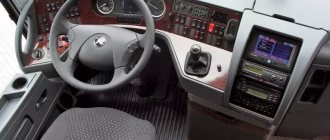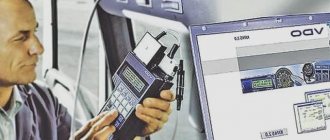A tachograph is a special device designed to monitor information about a vehicle and its characteristics. These include driving speed, a given route, driver rest mode and other important characteristics. The electronic device greatly simplifies control over the condition of the vehicle, helps prevent accidents and optimize the time spent behind the wheel. In 2021, a tachograph is a mandatory device for installation in all commercial vehicles, the absence of which can result in a fine. It is worth noting that devices produced in Russia are equipped with a special topographic protection function.
Regulatory framework, installation obligation in 2021
The presence of a writing device on a car is provided for in Art. 20 Federal Law-196 dated December 10, 1995. The law states that specific requirements are developed by the Government of the Russian Federation. By Decree of the Government of the Russian Federation No. 1213 of November 23, 2012, these powers were transferred to the Ministry of Transport. Order of the Ministry of Transport No. 36 dated March 12, 2013 contains the basic requirements for a tachograph and a list of persons required to install it. In accordance with Appendix No. 2 to the Order, all vehicles used for commercial purposes weighing from 3.5 to 12 tons are equipped with the device. In particular, the following vehicle groups fall into this category:
- intended for the transportation of passengers with more than 8 seats (weighing up to 5 tons or more);
- trucks weighing from 3.5 to 12 tons and more than 12 tons.
Thus, liability for the absence of an enterprise card for a tachograph is provided for by law only for persons using equipment for commercial purposes to make a profit.
IMPORTANT!
The Order also provides an impressive list of exceptions - a list of vehicles on which the device is not installed: for example, trolleybuses, cars for driving lessons, concrete mixers, truck cranes, ambulances and many others.
How to appeal tachograph fines
A fine imposed legally cannot be cancelled. But, if the sanction was applied incorrectly and you can prove it, the fine can and should be appealed.
Example 1: The inspector issued fines for the absence of a tachograph in the amount of 50,000 rubles, 5,000 rubles and 10,000 rubles, respectively, to the organization, driver and mechanic responsible for releasing the car onto the line. The inspector did not take into account that the car is used by the organization to service oil wells and is an exception exempt from the mandatory installation of a tachograph. In this case, the fines were imposed illegally and can be effectively appealed.
Example 2: When checked by an inspector, there was no paper tape in the tachograph. This served as the basis for punishment both for the driver, who must ensure the operation of the device in accordance with the Order of the Ministry of Transport, and for the person responsible for releasing the vehicle onto the line, and for the organization whose vehicle is used in violation of the requirements for the operation of tachographs. The inspector issued fines of 5,000 rubles, 10,000 rubles and 50,000 rubles, respectively. However, before the start of the trip, the organization drew up a document in which it was noted that the driver had a spare tape. Thus, responsibility for the lack of a spare tape should only be borne by the driver who, due to some circumstances, lost this tape. Fines of 10,000 rubles and 50,000 rubles imposed on officials and legal entities can be successfully appealed.
This can be done within 10 days from the date of receipt of the decision.
To cancel the fine, you must file a complaint with the authority that issued the decision. A complaint must be submitted in writing in one of two ways:
- upon a personal visit to the department that imposed the sanction;
- by post to the same office.
It is no longer possible to appeal fines online. Read more about this at the link. How to file a complaint is described in detail here.
10 days are allotted for consideration of the complaint. Then, within 3 days, the claimant must send a response to the applicant. If the complaint is not satisfied, you can go to court, attaching the received response to the statement of claim along with documents confirming that the sanctions were imposed without reason.
Checking fines for legal entities. persons
Monitor fines automatically, receive reports on new found fines and pay for them
Try for free
Is it possible to drive without a tachograph card for personal purposes?
The legislator emphasizes that a recorder is only required on machines used for commercial purposes. Thus, a fine for not having a tachograph card is not issued if the car is used exclusively for personal purposes. But this fact will have to be proven to the traffic police officers. In addition, if the car is even periodically used for business, including by tenants or other persons, the device also needs to be installed. You also need to take the card with you, even when driving a vehicle after work, for example, since it will be problematic for traffic police officers to prove travel for personal purposes.
Where to check tachograph fines
Like other car fines, tachograph fines can be checked:
- On the State Services portal;
- If the decision was made by the traffic police inspector, then on the traffic police website;
- If UGADN - then on the Rostransnadzor website;
- Through special sites and applications, such as Online Traffic Police
What difficulties might a fleet employee encounter here?
1. Enter information for each machine separately, which is quite labor-intensive: each site has a set of details necessary for verification. As a rule, these can be:
- resolution number;
- vehicle registration details;
- driver's license number;
- TIN of the organization.
2. The second difficulty is that inspections must be regular - fines can appear on any day.
Checking a large number of machines requires a lot of time and care, because... a mistake costs the company money (missing the period for payment with a 50% discount or blocking the current account by bailiffs).
Penalties after 01.11.2019
Already, traffic police officers are holding accountable officials of organizations that allowed travel without a card. From November 1, 2019, in accordance with Federal Law No. 216 dated July 26, 2019, this offense is included in Part 2 of Art. 11.23 of the Code of Administrative Offenses of the Russian Federation, and punishment is provided for both legal entities and individual entrepreneurs. The new fine for officials for not having a company card for a tachograph will increase significantly:
- for officials - from 7,000 to 10,000 rubles;
- for individual entrepreneurs - from 15,000 to 20,000 rubles,
- for legal entities - from 20,000 to 50,000 rubles.
When can a fine be avoided?
If the driver does not want to receive a fine - without a driver card for the tachograph or with a device that is broken or was not verified in time, it is better not to go on the trip. But there are a number of situations in which you can avoid a fine.
The first situation concerns the driver’s overtime, recorded by the flight recorder. If minor deviations from legal requirements are found, the driver can explain the reason for the violation. Sometimes (for example, when you get stuck in a traffic jam), it is physically impossible to interrupt driving in time - with proper motivation, a fine can be avoided.
In addition, no fine is imposed:
- If the card or tachograph fails during the flight. By law, the driver can complete the trip without interruption for repairs or ordering a new card - but he must record all intervals of the car manually.
- If the driver card is sent, it is not reissued as a result of breakdown or damage (but not expiration). To confirm this, you need to present to the traffic police officer the certificate issued when applying for re-issuance of the card.
In all other cases, an inspection that is accompanied by the discovery of violations is almost guaranteed to result in a fine for the driver. That is why the rules for operating a vehicle with a tachograph should not be violated: it is not difficult to comply with them, but it will be possible to avoid any claims during inspection.
Is it possible to get a discount
An offense such as the absence of a driver’s tachograph card entails a monetary sanction. In accordance with the law, for many violations a 50% discount is provided when paid within the first 20 days after the punishment is imposed. But it does not apply to this offense and is valid only for the articles specified in Chapter 12 of the Code of Administrative Offenses of the Russian Federation. Payment can be made in a convenient way, through the State Services website, without a personal visit to a bank or credit institution, but without a discount.
Where and how to get a driver card for a tachograph
You can apply for a driver card in different ways:
- By personal contact with the organization authorized to accept applications for the issuance and replacement of tachograph cards. On the Rosavtotrans website there is a list of such organizations with addresses in different cities of Russia.
- You can order a card online on the website of an accredited organization, attaching scanned copies of documents.
- You can also apply for a driver card at the MFC at your place of residence.
In all cases, you will need to provide a certain list of documents with copies:
- Passport;
- Driver's license;
- Photo black and white 3.5x4.5 cm;
- SNILS;
- TIN (for CIPF);
- Certificate-petition from the place of work (for CIPF).
You will also need to fill out an application for issuing a card and consent to the processing of personal data.
The cost of issuing cards ranges from 3,000 to 5,000 rubles, depending on the type of card and manufacturer.
The costs of issuing the card are borne by the employer in accordance with Art. 22 Labor Code of the Russian Federation.
Appeal against prosecution
An appeal against a fine is made to a higher authority or court. The deadline for filing is 10 days from the date of receipt of the resolution. The copy must be marked as having received the complaint. It is necessary to substantiate the arguments, therefore it is recommended that in the event of a device breakdown, make notes in your own hand on the back of the tachograph paper about all stops and intervals in continuous movement.
Legal documents
- Federal Law of December 10, 1995 N 196-FZ
- Decree of the Government of the Russian Federation of November 23, 2012 N 1213
- Code of Administrative Offenses
- Article 11.23 of the Code of Administrative Offenses of the Russian Federation. Driving a vehicle or releasing a vehicle on the line without a tachograph, failure to comply with driving and rest time standards, or violation of the work and rest schedule of drivers
- Federal Law of July 26, 2019 N 216-FZ
- Article 11.23 of the Code of Administrative Offenses of the Russian Federation. Driving a vehicle or releasing a vehicle on the line without a tachograph, failure to comply with driving and rest time standards, or violation of the work and rest schedule of drivers
Why do you need a tachograph?
At the end of the 1920s, road transport began to be actively used in Europe. Transport owners have a need to control “tools of labor” and employees located far from the enterprise. So the devices received an impetus for development and began to be constantly improved.
In Russia, tachographs were introduced in 1996 for international carriers. For domestic ones - since 2010. These were analog tachographs. They recorded the data on paper - a tachogram. The driver filled out information about the distance traveled by hand on a paper disk every day. These devices were not capable of storing the movement history, detailed changes in speed and the driver’s work and rest schedule. They were easy to fake. Therefore, from March 2, 2018, they were replaced by digital tachographs with a cryptographic information protection unit - CIPF. These devices store any manipulations in memory. Therefore, information from such a device is recognized as legally significant and can be used to clarify the circumstances of an accident and in court.
CIPF digital tachographs store information about:
- driver's driving and rest time;
- movement speed;
- distance traveled.
Thus, digital tachographs make it possible to monitor drivers’ compliance with work and rest schedules and speed limits.
Drivers often strive to complete their journey as quickly as possible - they exceed the speed limit and do not pay attention to physical fatigue. This reduces concentration on the road and creates the risk of an accident. A well-rested driver behaves more attentively on the road. Thereby preserving the life and health of other road users.
Check your organization's fines now
Device requirements
Any control device is installed in compliance with current regulations.
Tachometer requirements:
- presence of a motion sensor;
- chip card that records information about movement;
- working navigation modules;
- one-piece filling without damage or deformation;
- proper operation of all functions and the device as a whole.
In case of violation of the established rules, the law provides for a fine for a tachometer that does not comply with the current regulations.
Legislation
In addition to the above regulations, attention should be paid to the following Orders of the Ministry of Transport of the Russian Federation:
- No. 273 of July 13, 2013, “On approval of the Procedure for equipping vehicles with tachographs”;
- No. 470 of December 17, 2013 - a regulatory document amending Order No. 36 of February 13, 2013.
According to the above Orders, owners of vehicles of certain categories are required to install on them tachographs with a cryptographic information protection system.
The legislative deadline is set until January 1, 2019, allowing the use of old-style tachographs.
Major violations
The most obvious violation, which in 100% of cases is followed by sanctions from the traffic police, is the absence of a device on a vehicle that, by law, must be equipped with a tachograph. But there are other situations prescribed in the Code of Administrative Offenses and other regulations - they should also be avoided.
Device malfunction
The most common problem is a malfunction of the device. If the tachograph does not record vehicle movement parameters, does not accept a tachograph card, or does not perform other functions, it is considered faulty. From a legal point of view, operating a car with a faulty control mechanism is equivalent to driving without a tachograph, and is therefore punishable by a fine.
Important nuance! If the recorder breaks down already during the trip, the driver can continue driving, but only in the direction of the workshop or regular parking place. The maximum time for such movement should not exceed 7 days. In this case, the registration of the operating mode must be carried out manually by the driver (on a special form or the reverse side of a tape for printing data from the tachograph).
Not only malfunctioning of the system can be considered a sign of malfunction. If the inspection reveals damage to the housing or a violation of the integrity of the seals, the device will be considered faulty, regardless of its actual performance. The same applies to other methods of interfering with the design or operation of the system (disconnecting wires, connecting third-party devices, etc.).
Tachograph type mismatch
The next problem (it occurs quite rarely) is the discrepancy between the type of device and the nature of the flight being performed. In 2019, all cars must be equipped with digital control devices approved for use in the Russian Federation.
In addition, it is important that vehicles operating flights within the Russian Federation have tachographs with a CIPF/NKM cryptographic protection module.
For vehicles operating on international flights, the installation of AETR devices will be mandatory. Violation of this requirement is a reason for penalties (both from the Russian Traffic Police and from the inspection authorities of other countries).
No driver card
Current regulations require that:
- The tachograph was operated with a tachograph card (individual digital key on an electronic chip).
- The card was in the device during the entire operation of the vehicle.
- The card has not expired.
- The device contained a map of the person who is currently driving the vehicle.
Thus, driving without a chip card, with someone else’s, expired or faulty card is regarded as a violation. Both drivers and officials are fined for this (if it is their fault that the driver was released on a flight without a chip card).
Violation of service deadlines
The main maintenance work for flight recorders is verification (monitoring the compliance of measured indicators with actual ones) and replacement of the cryptographic module. Information about these operations is indicated in the device passport, and violation of the deadlines for verification or replacement of the CIPF unit is detected during any document check.
Operating an unverified device or recorder with an overdue replacement of the CIPF is equivalent to driving with a faulty device. As in the previous case, the driver or representative of the transport department who committed the violation can be fined.
Lack of calibration
Calibration is carried out when installing a tachograph on a car, during its repair, replacing wheels, speed sensors and other changes that can be made to the design of the vehicle. The main task of calibration is to ensure that the device accurately records all metrological parameters.
Important information
A tachograph is a device whose installation on a number of vehicles is mandatory. In its absence, the perpetrators face liability in the form of a fine.
Its value depends on which person committed the violation. The smallest fine will be for drivers, the largest amount of money will be taken from the official, and the maximum amount will be for the transport company itself.
The amount of the fine is not differentiated taking into account the nature of the violation committed. Any situation in which a vehicle is not equipped with a properly working tachograph is punishable by a fine in an amount within the same range.
Basic Concepts
| Tachograph | An on-board unit installed on vehicles, including trucks weighing more than 3,500 kilograms and buses equipped with eight or more seats for passengers |
| Fine | A sanction in administrative law, expressed in monetary payment in favor of the state. The fine can be applied to both individuals and legal entities (organizations) |
What is it for?
A tachograph is a device that serves to record a number of parameters of the flight performed by the driver of the vehicle.
The device remembers the distance traveled and the time spent. The speed achieved is recorded on it.
The device records the amount of time the driver spent on work (driving the vehicle and its maintenance) and rest during the shift.
This device can be useful in the event of an accident. It gives less deviation when recording speed than a speedometer; in the event of an accident, the driver can refer to its readings. Traffic police officers trust them more than speedometer data.
What regulations governs
Regulations governing the use of a tachometer include:
- Labor Code of the Russian Federation;
- Federal Law No. 196 “On Road Safety”;
- Technical Regulations of the Customs Union 018/2011 “On the safety of wheeled vehicles”;
- Order of the Ministry of Transport No. 36 “On approval of requirements for tachographs installed on vehicles...”
- Code of Administrative Offenses (CAO).










